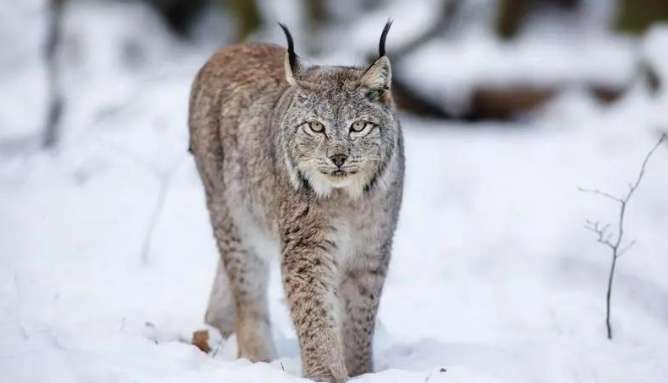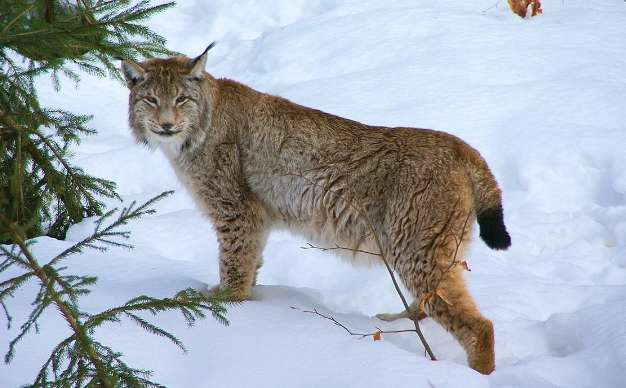After the ecological environment gradually improves, it is nothing new for people to encounter wild animals in the wild. Especially in some areas where the ecological environment is relatively superior and wild animals are frequent, it is common to witness some "exotic animals".
A man recently encountered an "unknown beast" in the woods near Woniu Lake Scenic Area in Aihui District, Heihe City. The man was driving on a mountain road when an animal of medium size suddenly jumped out from the side of the road. From the appearance, it looked a bit like a cat and should be a wild cat.

At first people thought It is a stray cat, but a closer look reveals that it is much larger than a cat, and its appearance is also somewhat different from that of a cat.
The wild animal in the picture has a thick body, thick and long limbs, and a short tail that is extremely disproportionate to the body. Interestingly, there are black tufts on the tips of its ears.
The animal was very vigilant, but not very afraid of people. After looking at each other for a while with the man in the car, it turned and walked into the woods, eventually disappearing from sight.
In fact, the wild animal found by the man in Heihe was a lynx, also known as "lynx" among the people, and it is a medium-sized cat. This is a very ferocious beast, and many netizens said after seeing it that it can kill a wolf.
Eurasian lynx: short tail, tufts of hair on the ears
"Short tail, tufts of hair on the tips of the ears" are the most obvious characteristics of the lynx. In a broad sense, there are four species of lynx, all of which are under the genus Lynx. They are: Eurasian lynx, Iberian lynx, Canadian lynx and bobtail cat. However, most of the time people do not refer to bobtail cats. Cats are called lynx.
Lynx in a narrow sense only refers to the Eurasian lynx, which is the largest of the four lynx species. It weighs 18-30 kilograms as an adult, which is about the same as a small or medium-sized dog. Much larger than the average house cat. Compared with many small predators in the Cat subfamily, the Eurasian lynx is relatively large, and its combat effectiveness is also at the ceiling of small and medium-sized cats.

The color of the hair on the Eurasian lynx is related to the environment it is in. It is mostly light brown, khaki brown, light gray brown and gray white. The color is brown in spring and summer, and gray in autumn and winter. They have spots on their bodies, so in the past they were often mistaken for small leopards.
The limbs of the Eurasian lynx are very thick and proportionally large. This body structure gives the lynx a strong ability to move, and it can play a greater role in hunting down nimble and fast prey such as hares.
Because they live in the north, winter It will be covered with a thick layer of snow, so the lynx will grow long and dense hair on its large paws to facilitate movement in the snow.
Widely distributed in northern Eurasia
The lynx is a cold-loving animal that mainly lives in the north. As the name suggests, the Eurasian lynx is a lynx that lives in Eurasia.
It has a wide distribution range , its habitats are extremely diverse, ranging from subarctic coniferous forests, to alpine scrub grasslands, and even semi-desert areas. They are generally found in forest scrub areas or dense forests and rocks.
Lynx is a solitary hunter and is nocturnal. During the day, it usually hides in rock caves and stone crevices to rest and bask in the sun. In the evening, it comes out to look for food, and sometimes even stays active all night, until the early morning. Its activity range is greatly affected by the abundance of prey. The more abundant the prey, the smaller the activity range, and vice versa.
The prey of the Eurasian lynx is relatively wide, ranging from various small rodents to small wild boars. , roe deer, etc. They often use ambush methods to capture prey. Grass, stones, and big trees in the environment are natural shelters. When the prey enters its ambush circle, the lynx will rush out and capture the prey. It bites hard.
It is extremely resistant to hunger and cold. Sometimes it can lie still in one place for several days. The thick hair on its body has excellent thermal insulation properties, but it is warm and humid in the south. The area is not suitable for the long-term survival of lynx.
In forests where tigers and leopards are generally lacking, a situation of "golden cats in the south and lynx in the north" has formed. Lynx has become a new species in most forests in the north. The king of beasts.
He has a fierce personality and is known as the "Little Wolf Slayer"
It is not an exaggeration to say that lynx can kill wolves. In fact, they do have such strength. The Nalipoki Forest in central and western Belarus is a relatively superior ecological environment forestForests are home to a variety of wild animals, including the Eurasian lynx and the European forest wolf, a pair of enemies.
After long-term ecological research, zoologists from the Belarusian Academy of Sciences have discovered that there is a strong inter-species competition between lynxes and wolves here, and the two sides often fight to the death.
Judging from the results, it seems that the lynx is the winner. The European forest wolf was once killed off and had no descendants. In some years, its reproductive capacity was zero.
Wolves are social animals. Many people may not understand how a lynx, which is not dominant in size, can kill a wolf? First of all, European forest wolves are not large, and some are not even as big as male lynxes. Secondly, the wolves here do not always live in groups.
Every year from April to September, it is the warm season in Nalipoji Forest. At this time, there are an abundance of small mammals in the forest, and the foraging efficiency of lone wolves is much higher than that of pack wolves. Therefore, wolves at this time are more inclined to act alone, and the number of lone wolves even exceeds the number of wolves living in groups, which gives the lynx the opportunity to ambush and kill them.
In fact, even adult male giant lynx will not provoke wolves. Its targets are mostly lone wolves, pregnant female wolves, and wolf pups.
Under the oppression of lynx, zoologists have found that the mortality rate of wolf pups remains high, once reaching 40%-60%. In forest patches with relatively high lynx densities, the mortality rate of wolf pups remains high. The mortality rate of cubs is even as high as 90%. In contrast, regarding lynx, although wolves will also kill lynx pups, the forest is the home of lynx, and the survival rate of its pups can be maintained at about 80%.
Among the 13 species of cats in my country, the lynx is a very special existence. It is very beautiful, very strong, and its number is not small, about 70,000, and it is a national second-level animal. ANIMAL CROSSING.
